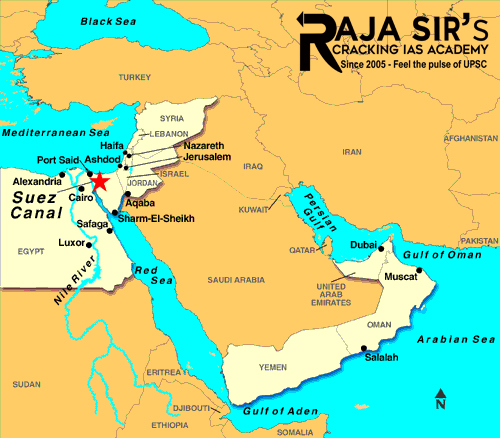- Home
- Prelims
- Mains
- Current Affairs
- Study Materials
- Test Series
 EDITORIALS & ARTICLES
EDITORIALS & ARTICLES
Suez Canal - An economic lifeline
The world would never be the same after the Suez Canal officially opened to ships on 17 November 1869. The 193-km artificial waterway that connects the Red Sea to the Mediterranean through the Isthmus of Suez cut down the sea route from Asia to Europe by up to 7,000 km by negating the need for ships to travel around the southern tip of Africa to traverse between the Indian and Atlantic Oceans. Today it is one of the world’s busiest waterways, handling roughly 12 per cent of global commerce.
 Canals’ construction
Canals’ construction
- A trade route through Suez connecting Europe and Asia can be traced to antiquity. There is some evidence of a canal being constructed in the region during the reign of Pharaoh Senausret III, who ruled in the second millennium BCE.
- But the idea for the modern-day canal can be traced to the eighteenth century, during the peak of European colonial expansion. In 1799, Napoleon’s efforts to build a canal were thwarted by inaccurate measurements.
- It was French diplomat and engineer Ferdinand de Lesseps, whose efforts to win over the support of the Egyptian viceroy Sai’id Pasha for support for the canal’s construction that eventually bore fruit. In 1858, the Universal Suez Ship Canal Company was tasked to construct and operate the canal for 99 years, after which rights would be handed to the Egyptian government.
- After more than ten years of construction, which claimed thousands of lives — Egypt’s future leader Gamal Abdel Nasser claimed that there were 12 lakh worker fatalities — and was faced with many obstacles including crippling financial difficulties, the canal was opened for international navigation in 1869.
Choppy history
- French and British investors held most of the shares in the canal company. The canal was used by European powers to maintain their maritime and colonial interests in Asia and eastern Africa. The British, after a 1936 treaty, maintained a massive defensive force along the Suez Canal Zone.
- But as a curtain drew upon European empires, the Suez Canal became a major flashpoint. In 1954, facing pressure from Egyptian nationalists, Britain signed a treaty that would see the withdrawal of British troops from Suez in the next seven years. This was, however, never going to be enough.
- In 1956, then Egypt President Nasser nationalised the Suez Canal. He declared that the revenue from the busy trade route would pay for the construction of the Aswan dam on River Nile, which would generate electricity for his country and prevent the river from flooding each year.
- This triggered the Suez Crisis, which saw the UK, France, and Israel mounting an attack on Egypt. The alliance was successful militarily, politically the war ended up as an undeniable victory for Nasser and his Egyptian nationalists. Eventually, the occupying forces of the alliance were forced to withdraw and the UN, for the first time, deployed Peacekeeping Forces to act as a buffer between Israel and Egypt.
- In 1967, Nasser ordered the UN forces to exit Sinai, leading to another conflict between the two countries. In response to Nasser’s order, the Israelis occupied Sinai, in response to which Egypt closed the canal to all shipping for the next eight years.
- This was not the first instance of the canal being shut. It would also not be the last. In March 2021, container ship christened MV Ever Given, en route from China to the Netherlands, got stuck in one of the canals’ narrower stretches. The blockage lasted for the next six days, leading to hundreds of ships getting stranded and disrupting global commerce.
An economic lifeline
- Upon its construction, the Suez Canal became the lifeline for all trade between the East and the West. Today, roughly 12 per cent of global trade, 7 per cent of the world’s oil, and 30 per cent of daily container traffic passes through the canal. More than 20,000 ships pass through the canal daily.
- The six-day blockage in 2021 triggered inflation globally. As maritime historian Sal Mercogliano told The Associated Press, “Every day the canal is closed… container ships and tankers are not delivering food, fuel and manufactured goods to Europe and goods are not being exported from Europe to the Far East.”
- For the highly interconnected global economy of the modern world, this can be disastrous. According to some estimates, during the blockage, the value of the goods delayed each hour was some $ 400 million.









 Latest News
Latest News General Studies
General Studies